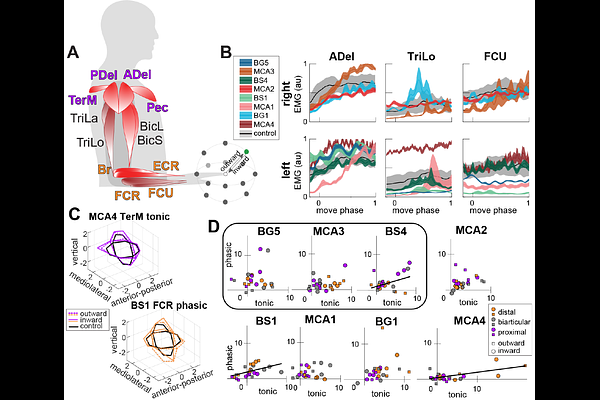Stroke-Related Changes in Tonic and Phasic Muscle Recruitment During Reaching Reveal Pathway-Specific Motor Deficits

Stroke-Related Changes in Tonic and Phasic Muscle Recruitment During Reaching Reveal Pathway-Specific Motor Deficits
Korol, A. S.; Adcock, A.; Gritsenko, V.
AbstractBackground and Purpose: Upper limb motor deficits are common after stroke and often persist despite rehabilitation. Clinical assessments focus on movement quality but fail to quantify underlying neuromuscular impairments, especially in individuals with mild deficits. We aimed to characterize stroke-related changes in muscle recruitment during reaching by separating tonic (gravity-compensating) and phasic (intersegmental dynamics-related) components of electromyographic (EMG) activity and assessing their relationship to motor impairment. Methods: We recorded surface EMG from 12 upper limb muscles during goal-directed reaching in 8 participants with unilateral ischemic stroke and 9 age-matched controls. Using principal component analysis, we extracted tonic and phasic components of muscle activity and compared their amplitude, directional tuning, and coactivation patterns across groups. Score differences between stroke and control groups were analyzed using generalized linear mixed-effects models, regression analyses, and correlation with time since stroke and previously published muscle torque-based performance indices. Results: Individuals with stroke exhibited disrupted muscle recruitment even with mild motor deficits. Proximal muscles were over-recruited in directions that normally require less muscle activation, indicating abnormal directional tuning. Phasic activation of distal muscles was significantly reduced and declined further with time post-stroke (R2 = 0.52, p = 0.002), while tonic overactivation of proximal muscles was present in all participants with stroke. Coactivation between multiple muscles was altered, with right-hemisphere stroke reducing tonic coactivation in contralateral arms and left-hemisphere stroke increasing it. Abnormal phasic coactivation between proximal and distal muscles was present and correlated with impaired limb propulsion (R2 = 0.67, p = 0.013). Tonic and phasic recruitment deficits were often correlated, suggesting shared disruption of corticospinal and reticulospinal pathways. Conclusions: Stroke causes distinct yet interacting impairments in tonic and phasic muscle recruitment that underlie individual motor deficits. These findings support the need for neuromechanically informed assessment tools that target specific motor pathways to guide individualized rehabilitation strategies.